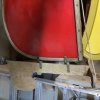divedog
LOVES Wooden Canoes
I could sure use some help identifying this boat I picked up! It was the seller’s parents’ Northern California lake house boat, and had been in the family a long time. Seller called it an “OT 1955 Voyager”.
It is 16 feet long and about 40 inches wide and 16 inches deep amidships. No serial number is stamped on the stems, which are 1 3/8” wide. It has outside stems and a keel. The inwales and outwales are not tapered.
Ribs are 5/16” thick and vary in width from 1 5/8”- 2 1/18”. Spacing between ribs also varies, but averages about 1 7/8”. Planking is 3 ¼” wide.
Original oar locks are galvanized and magnetic. I do not have the horns.
It was sailed by the family, but not everything seems original. The mast step is mounted to the floor rack, which does not fit between all the ribs in the boat. The seats are very crude (like 1970’s kitchen cabinetry) and I’m guessing are not original. The mast fits in a metal bracket attached to a seat.
Thanks in advance for your help!
Mike Wootton - Spokane, WA
It is 16 feet long and about 40 inches wide and 16 inches deep amidships. No serial number is stamped on the stems, which are 1 3/8” wide. It has outside stems and a keel. The inwales and outwales are not tapered.
Ribs are 5/16” thick and vary in width from 1 5/8”- 2 1/18”. Spacing between ribs also varies, but averages about 1 7/8”. Planking is 3 ¼” wide.
Original oar locks are galvanized and magnetic. I do not have the horns.
It was sailed by the family, but not everything seems original. The mast step is mounted to the floor rack, which does not fit between all the ribs in the boat. The seats are very crude (like 1970’s kitchen cabinetry) and I’m guessing are not original. The mast fits in a metal bracket attached to a seat.
Thanks in advance for your help!
Mike Wootton - Spokane, WA























